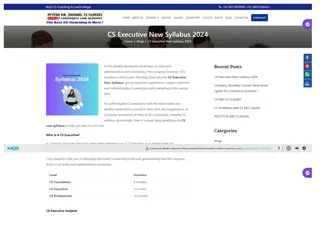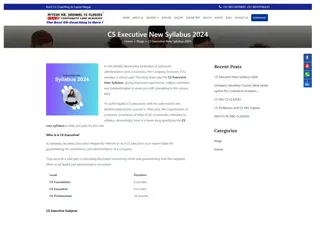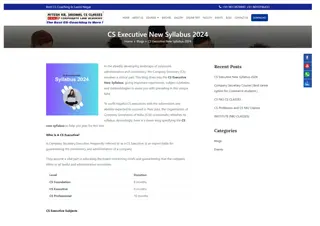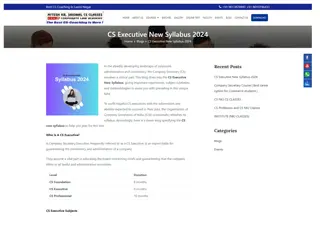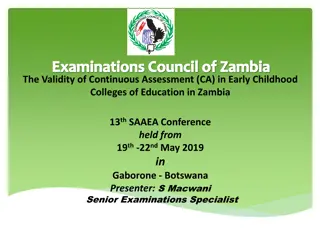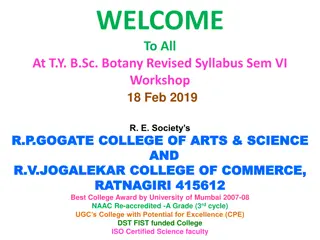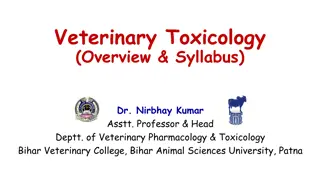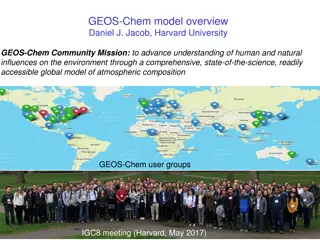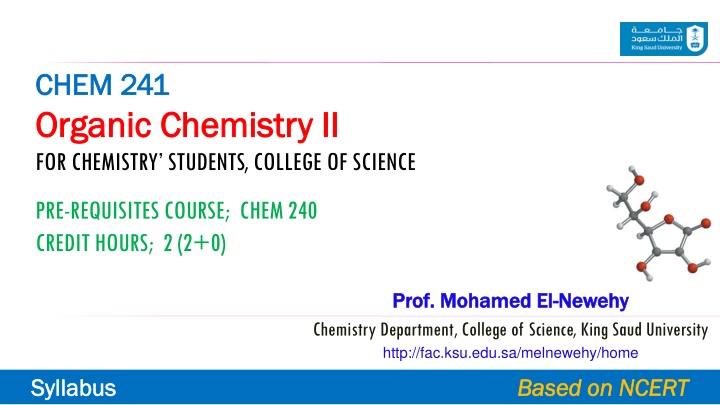
Organic Chemistry II Course Overview and Objectives
This post outlines the syllabus, topics covered, assessment tasks, and objectives of the Organic Chemistry II course. It covers various functional groups, mechanisms of reactions, and schemes of multi-step reactions to help students understand organic chemistry principles effectively.
Download Presentation

Please find below an Image/Link to download the presentation.
The content on the website is provided AS IS for your information and personal use only. It may not be sold, licensed, or shared on other websites without obtaining consent from the author. If you encounter any issues during the download, it is possible that the publisher has removed the file from their server.
You are allowed to download the files provided on this website for personal or commercial use, subject to the condition that they are used lawfully. All files are the property of their respective owners.
The content on the website is provided AS IS for your information and personal use only. It may not be sold, licensed, or shared on other websites without obtaining consent from the author.
E N D
Presentation Transcript
CHEM 241 CHEM 241 Organic Chemistry II Organic Chemistry II FOR CHEMISTRY STUDENTS, COLLEGE OF SCIENCE PRE-REQUISITES COURSE; CHEM 240 CREDIT HOURS; 2 (2+0) Prof. Mohamed El Prof. Mohamed El- -Newehy Chemistry Department, College of Science, King Saud University http://fac.ksu.edu.sa/melnewehy/home Newehy Syllabus Syllabus Based on NCERT Based on NCERT 1
Topics to be Covered Organic halides Types Physical properties - Preparation and reactions (nucleophilic substitution reactions SN1 and SN2 - elimination reactions E1 and E2). Lectures Lectures ( (3 3) ) Quiz 1 (4th week) Alcohols & Phenols Nomenclature IUPAC properties - synthesis and reactions of alcohols and phenols, their applications. Lectures Lectures ( (3 3) ) 1st Midterm Exam (7th week) Ethers and Epoxides Nomenclature, properties, synthesis and Reactions. Lectures (1) 2
Topics to be Covered Aldehydes and Ketones Nomenclature, properties, synthesis and Reactions, nucleophilic addition reaction and their reactivity's and applications. Lectures (3) Quiz 2 (12th week) Carboxylic acids and their derivatives Nomenclature, properties and acidities, synthesis and reactions and their applications. Lectures (2) 2nd Midterm Exam (13th week) Amino compounds Nomenclature, properties-basicity, synthesis and Reactions and applications in organic synthesis via diazonioum salts derivatives. Lectures (1) Final Exam 3
References References Organic Organic Chemistry, Chemistry, Francis Francis A A. . Carey, Carey, 6 6th th ed ed. ., , McGraw McGraw- -Hill Hill Company Company 2007 2007. . Fundamental Fundamental of of Organic ed ed. . John John Wiley&Son Wiley&Son, , New Organic Chemistry, Chemistry, T T. . W W. . Graham New York York (latest) (latest). . Graham Solomons Solomons and and Craig Craig Fryhle Fryhle, , 7 7th th Fundamental Fundamental of of Organic Hassan Hassan , , Dar Dar Alkharigy Organic Chemistry, Chemistry, Pro Alkharigy 4 4th th 1421 1421H H (Arabic Pro. . Hassan Hassan Al Al- -Hazimi (Arabic Edition) Edition) Hazimi and and Mohamed Mohamed Al Al- - 4
Schedule of Assessment Tasks During the Semester Proportion of Total Assessment 10 % 10 % 20 % 20 % 40 % 40 % Assessment task Week Due 1. Home work & Projects 2. Quizzes 4. 1st Midterm exam 5. 2nd Midterm exam 6. 6. Final exam Final exam All weeks 4, 12 7 13 16 16 2019/11/21 1441/03/24 ( ) 5
COURSE OBJECTIVES Upon successful completion of this course, the student will be able to: o Recognize the bases of the nomenclature, preparation and chemical behavior of the related functional groups: organic halides, alcohols, phenols, ethers, epoxides, aldehydes, ketones, carboxylic acids and their derivatives in addition to amines. o Describe the mechanisms of reactions, in particular nucleophilic, electrophilic substitution, elimination reaction and nucleophilic addition. o Outline the Scheme of the reaction including multi step reactions o Estimate the reactivity of organic compounds towards electrophilic, nucleophilic substitutions and addition reactions.
Course Learning Outcomes 1. 1. Knowledge Knowledge To name the different functional groups and organic compounds correctly and the types of alkyl halides. To recognize the difference between SN1 & SN2. To describe the nucleophilic substitution reaction. To describe the physical and chemical properties of organic compounds. To memorize the differences substitution and elimination reaction. To list the difference between electrophilic and nucleophilic reactions. To outline a scheme including multi step reaction. 1.1 1.1 1.2 1.2 1.3 1.3 1.4 1.4 1.5 1.5 1.6 1.6 1.7 1.7
Course Learning Outcomes 2.0 2.0 Skills 2.1 2.1 To estimate the reactivity of organic compounds towards electrophilic and nucleophilic substitution reactions. 2.2 2.2 To differentiate between substitution and elimination reactions. 2.3 2.3 To explain the effect of leaving group on reactivity toward substitution reaction. 2.4 2.4 To compare between SN1 & SN2 and between E1 & E2. 2.5 2.5 To summarize the major requirement for substitution or elimination reaction Skills 3.0 3.0 Competence Competence 3.1 3.1 Choose the best synthetic rout for a specific organic compound. 3.2 3.2 Illustrate the mechanisms of nucleophilic substitution and elimination reactions. 3.3 3.3 Justify the reactivity of carbonyl group. 3.4 3.4 Develop the ability to effectively communicate scientific information in written and oral formats. 3.5 3.5 Show professionalism, including the ability to work in teams and apply basic ethical principles.

